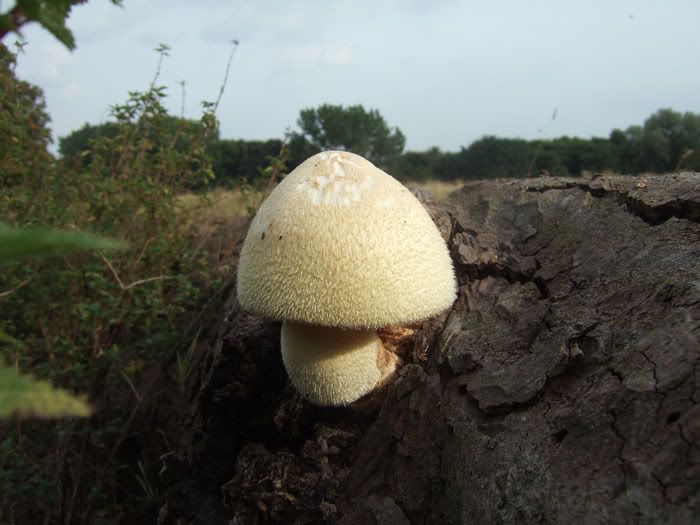

It's growing on a decaying tree trunk and stump (probably horse chestnut) in Pishiobury Park just north of Harlow on the Essex/Herts border, and behind Victoria Beckham's garden. The fungus emerges looking like a quail's egg, from this comes what looks like a white furry goose-egg. This opens out to the size of a large teacup or small pudding basin with a furry stalk.
We've looked through three fairly detailed mushroom and fungi identification books and also looked at the web site Rogers Mushrooms, so far without success. Surely such a dramatic and distinctive fungi should be easy to identify. Does anyone know?






Wish I did. It's gorgeous!
ReplyDeleteI had a suggestion from someone that the fungi may be a lycoperdon, which I think is a kind of puffball, but the structure of the stalk is quite distinctive and unlike any of the puffball fungi.
ReplyDeleteThe furry fungi has now been positively identified, by mushroom expert John Wright (aka The River Cottage Wild Food Man), as
Volvariella bombycina or Silky Rosegill
which is extremely rare in the UK. John obviously knows his fungi, and it's no surprise he has written the new River Cottage Mushroom Handbook.
Is it edible?
ReplyDeleteHi Toffeeapple - I understand it is edible but as it's rare and easily confused with some of the Amanita fungi which are seriously poisonous, it's best to leave it alone.
ReplyDeleteNot I, but enjoyed the photos!
ReplyDeleteHi Celia, thanks for leaving a comment on my blog. I'm glad that you liked the carrot cake recipe. I find myself going back to that recipe often when I am thinking of baking a cake.
ReplyDeleteI'm afraid that I have no knowledge of mushrooms, but I think it looks cute due to the fur. :-)
That is beautiful - I'm glad that you were able to find out what it was. Imagine seeing something rare like that.
ReplyDeleteHere is a link to a really fantastic fungi index... http://www.uoguelph.ca/~gbarron/species.htm
ReplyDeleteI found some images similar to the one posted, but none quite like it. Thanks for sharing. It will likely be an enjoyable experience browsing through the list....I found many types that I haven't yet seen online.
Good Luck!